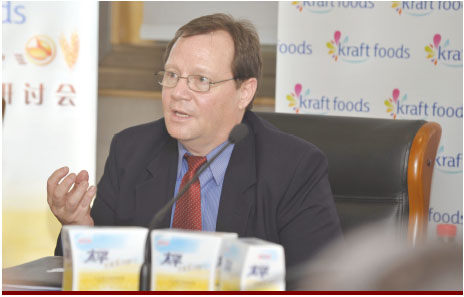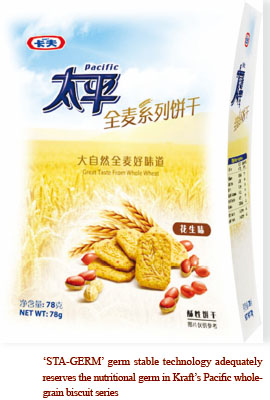AWARENESS of the importance of whole grain foods is growing in Asia, and whole grains are poised to be in more foods as consumers seek to attain better health through their diet. A dichotomy exists, however, between awareness and consumption habits survey. For instance a survey by Kraft Foods on whole grain knowledge and purchasing practices targeted at consumers in Beijing, Shanghai and Guangzhou at the end of 2009 indicated that whilst 85% of the respondents recognised the importance of coarse grain, over 90% did not habitually eat coarse grain on a daily basis. Just over 60% of those surveyed actively chose not to purchase whole grain products mainly due to their lack of confidence in such products available in the market.

'We have put a greater focus on the improvement of whole grain products, striving to provide consumers with whole-grain food options of both nutrition and taste preference'- John Nielson, Kraft Foods Asia Pacific
Whole grains are made of all three components of the grain, namely the endosperm, bran and germ. Whilst this basic definition is well known in the industry, the lack of regulatory standards and processing know-how means sub-par products on the shelf. The lack of clearly defined regulatory standards results in the confusion that consumers face when they try to purchase such products. John Nielson of Kraft Foods Asia Pacific acknowledges the growing awareness, but also the challenges producers of whole grain products face. "In recent years people have become more concerned with health and recognise whole grain as an indispensable component in a healthy diet," said Mr Nielson, who is associate director for Scientific Affairs/Regulatory Affairs/Nutrition for the global powerhouse in snacks, confectionery and quick meals. Until quite recently, technology to process whole grains resulted in products that did not appeal to modern consumers. More producers adopted processing technology resulting in the wastage of the germ - the most valuable nutritional reserves in the grain, which results in a loss of the richness of B-complex vitamins and other important nutrients. In many ways, manufacturers have done so in response to consumer preferences. Traditionally, processed foods only use the endosperm from the whole grain for products such as biscuit, bread and noodles. "Historically many grain-based foods have built product portfolios around the use of refined starches and flours, removing the germ and bran from the whole grain. Reasons for this are varied but generally include product stability, consumer taste and mouth-feel preference," Mr Nielson explained. In the past, whole grain foods tended to be a very small market because their flavour and texture profile was not acceptable to the majority of consumers. Flavour factors were a particular challenge. "I think it's more due to consumers' taste, because you can make many whole grains food but they have a very unique flavour profile that doesn't come up to most people's expectations," he noted, adding that the preference was not unique to the Asians, but true for consumers worldwide. "The industry had to overcome this with unique technology to deliver a whole grain product that approaches the flavour preferences of consumers." Technology catches up Kraft started working on producing whole grain products in the United States about 15 to 20 years ago, but it was only in the last five years that improvement in processing technology allowed the world's second largest food group to market consumer acceptable products. "From a taste and functionality perspective, we had to work very carefully and use technology to be able to come up with products that consumersJunior
In the past, whole grain foods tended to be a very small market because their flavour and texture profile was not acceptable to the majority of consumers. Flavour factors were a particular challenge. "I think it's more due to consumers' taste, because you can make many whole grains food but they have a very unique flavour profile that doesn't come up to most people's expectations," he noted, adding that the preference was not unique to the Asians, but true for consumers worldwide. "The industry had to overcome this with unique technology to deliver a whole grain product that approaches the flavour preferences of consumers." Technology catches up Kraft started working on producing whole grain products in the United States about 15 to 20 years ago, but it was only in the last five years that improvement in processing technology allowed the world's second largest food group to market consumer acceptable products. "From a taste and functionality perspective, we had to work very carefully and use technology to be able to come up with products that consumersJunior
 iConnectHub
iConnectHub
 Login/Register
Login/Register Supplier Login
Supplier Login


























